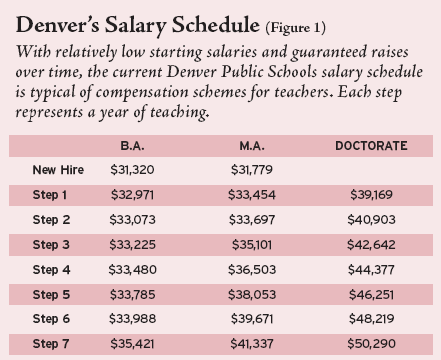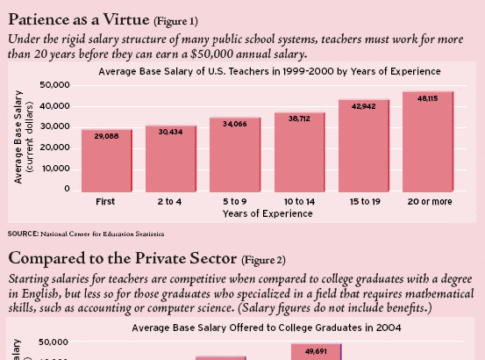It is by now a familiar story, often told as a lament: teachers in this country continue to be paid according to the single salary schedule.
They accrue better pay on the basis of years of experience and college units earned. Units may or may not be related to teaching assignment. Some districts have modestly tweaked this arrangement by paying a premium to teachers who earn certification through the National Board for Professional Teaching Standards. But by and large, in thousands of school districts across the United States, the unvarnished standard single salary schedule prevails.
Teacher unions, among the staunchest defenders of the standard compensation arrangement, are often credited–or blamed–with inventing this salary calculus. In fact, the classic teachers’ salary arrangement is an artifact of civil service. Developed in the early 1920s, the system was popularized three decades later as a way of creating salary equity between elementary teachers, most of whom were women, and secondary teachers, most of whom were men. This was not a pre-feminist revolution so much as a necessary economic response to the post-World War II enrollment boom. Over time, to be sure, teacher unions have come to defend the standard single salary schedule in the name of employee equity and fairness.
The National Education Association assiduously avoids anything that might be construed as “merit pay.” The position taken by the American Federation of Teachers is less rigid, yet replete with caveats to protect against anticipated slights and abuses. The unions’ position is not unwarranted. Merit pay schemes that have been tried in education have an abysmal track record (see “Dollars and Sense,” for one that had a decent record–while it lasted).
Part of the problem, however, has been that merit pay systems are rarely based on objective standards, a flaw that often created unhealthy competition for the usually scarce resources rather than cooperation among teachers. These insufficient funds all too typically forced many teachers to take their rewards solely in the form of psychic remuneration.
Compounding the compensation dilemma, policies promoted by both districts and unions have endeavored to maintain the fiction that “a teacher is a teacher is a teacher.” Compensation structures have failed to recognize that some teaching jobs are more difficult than others or that some teachers are more–or less–skilled than others.
Salaries for the Real World
The time has come for school districts and teacher unions to take a different tack. It is time to develop and implement a professional compensation arrangement that recognizes the complex nature of the work of teaching and that compensates teachers for both the difficulty of the assignment and the professional accomplishment that is part of it.
We need a compensation structure that utilizes multiple approaches. These should include paying teachers more for: 1) attaining knowledge and skills that demonstrably contribute to improving student learning; 2) mentoring newer and less skilled teachers; 3) teaching in hard-to-staff schools and choosing difficult-to-staff subjects; 4) producing higher test scores, using a value-added approach.
These ideas fly in the face of long-established tradition. But it’s time to reexamine that tradition. It’s time to acknowledge publicly that some teaching jobs are more difficult than others. And we must be willing to pay more for some fields than for others. In a perfect world, perhaps, a physics teacher is no more valuable than an English teacher. But we do not live in a perfect world. We live in a world in which physics teachers are at a premium, and for the foreseeable future supply and demand will need to prevail. The market must have its way.
Some will argue that what is suggested above is too complicated, that it is time to scrap the old salary schedule and pay teachers on the basis of their students’ test scores alone. After all, assert proponents of this argument, isn’t the true measure of a teacher’s worth her students’ test results? In fact, at the base of this argument lies the same fault line that threatens No Child Left Behind. Making judgments about student learning by simply examining test scores from one year to the next is hazardous at best. Tests provide a simple snapshot in time and may not be well aligned with standards or curriculum. Moreover, particularly in urban districts, given the rate of student transience, the cohort of students tested at the beginning of the year may be different from that tested at the end of the year, thus providing few useful comparative data.
The New Math for Merit
But there is a way to use test scores to gain needed information about the impact of teaching and the levels of student learning: value-added calculations. The value-added approach has the advantage of separating student effects (ethnicity, family background, socioeconomic status) from school effects (teachers, administrators, programs) since it examines test scores to determine if students are making anticipated academic gains each year. Measured on the basis of their progress from the previous year, students, in a sense, act as their own statistical control. Value-added programs calculate a projected test score for a student in a given grade or subject based on his or her previous academic achievement. The difference between the actual score and the projected score is the value added.
Value-added calculations, however, should not be used as the sole gauge of teachers’ compensation. They too are an imperfect technology. But they can, and should, serve as one important measure. Consistent value-added work by William Sanders in Tennessee has shown that several consecutive years of teachers’ adding measurable value to students’ learning provide a foundation on which students can continue to make academic progress. After several years of ineffective teaching, students may never recover academically.
Finally, it is not possible to discuss teachers’ compensation without taking up the issue of their evaluation. In most places, evaluation is done poorly, with checklists about behavior standing in for standards of good practice that should frame evaluation systems. Administrators typically in charge of the process have too little time or training to effectively help teachers improve their practice.
But there is an effective alternative to the ineffective evaluation as well. Systems of peer review, in place for a decade or more in a dozen or so districts–such as Toledo and Columbus, Ohio; Rochester, New York; and Montgomery County, Maryland–have shown remarkable promise. Beginning teachers are provided the support they need from specially selected experienced teachers, who are chosen jointly by the district and the union. Those individuals who were not meant to be teachers are soon out of the profession. Struggling tenured teachers are given the support they have long needed. Should that not prove adequate, they are encouraged to find other lines of work. Conventional wisdom notwithstanding, teachers, including unionized teachers, are able to judge their colleagues fairly but rigorously. Yes, some teachers are dismissed. More important, evaluation accomplishes the purpose for which it is intended: improving professional practice.
Working with Complexity
Marrying a well-developed system of peer review and value-added test scores could create a powerful framework for teachers’ compensation. Adding pay for knowledge and skills, compensation for mentoring, and pay for teaching in hard-to-staff schools and subjects will transform a pro-forma salary schedule into a professional compensation arrangement that better recognizes the complexity of teaching and offers teachers the kinds of incentives and options that professionals deserve.
Salaries by themselves, no matter how high or competitive, will not encourage teachers to remain at schools where the working conditions are poor. Competent, supportive administrators, a decent physical plant, and requisite instructional supplies are the sine qua non for maintaining a quality teaching staff, regardless of the rate of pay.
In sum, it is time to construct a salary schedule that gives teachers choices, opportunities, and options–pay for knowledge and skills, pay for mentoring, added pay for hard-to-staff schools and subjects, and added compensation for test scores calculated using a value-added approach.
The hope is that progressive unions and districts will take up the challenge to shape this new salary construct. They will come to see rethinking compensation as part of their obligation to promote quality teaching, and as the next step on the road to creating a true profession.
Julia E. Koppich is an education consultant based in San Francisco. A former high school teacher and faculty member in the school of education at the University of California, Berkeley, she is also coauthor of United Mind Workers: Unions and Teaching in the Knowledge Society.





